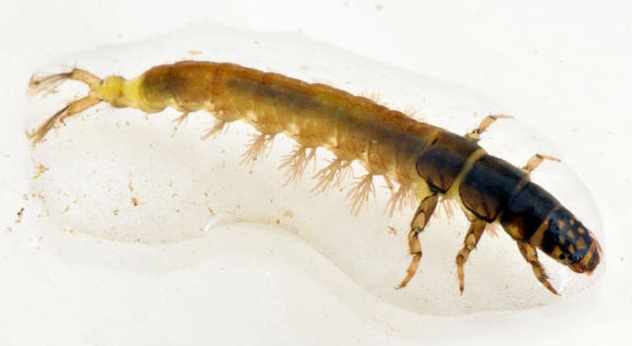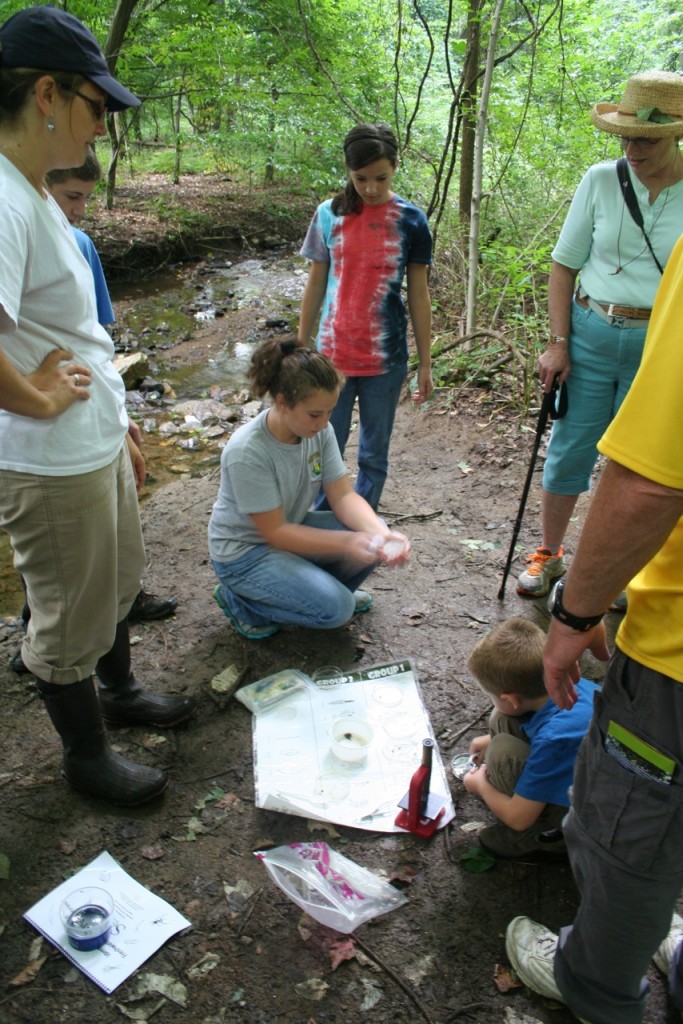How can you know when a stream is healthy or not? When it comes to determining water quality, the things that are living in the water are a major clue!

When people think of healthy streams, they often think of fish, turtles, and other large aquatic life. It’s true that these animals can indicate a healthy stream. But sometimes, even smaller animals can help paint a larger picture. Insects, and other macroinvertebrates (animals without a backbone that you can see without the help of a microscope, “macros” for short), are among the best indicators of stream health. According to Stroud Water Research Center, macros “are advantageous in evaluating water quality because they have relatively diverse assemblages (100-200 species) and as a group are a sensitive measure of environmental change and stress.” This means that the bugs and other macros living in a stream tell us different things about that stream.
To complete a survey of macros living in a stream, scientists may take a large net, known as a kick net, out into the center of the stream near a riffle (a relatively shallow, rocky area of a stream where water flows at a higher speed). They then stir up the stream bed above the net by moving and rubbing down rocks and using their feet to kick up sediments at the bottom of the stream. This washes any organisms living in or on the stream bed into the net. Tiny snails, leeches, worms, dragonflies, and crayfish are just some of the kinds of macros that scientists look for when they pull that net out of the water for examination.
Here are some of the major kinds of macros and what their presence indicates:
- Mayflies, caddisflies, and stoneflies: These organisms and their larvae have a very low tolerance for contamination, which means that they need clean, unpolluted waters. Where they’re found, a stream is usually in healthy shape.
- Dragonflies, crayfish, and clams: These organisms and their larvae can handle moderate amounts of contamination. They can be found in mildly polluted streams where the more sensitive macros can’t survive. However, they’re not totally resistant, and have difficulty surviving in waters that are heavily polluted.
- Lunged snails, aquatic worms, and leeches: These organisms and their larvae can handle the polluted streams where few other creatures can survive. When these animals represent the majority (or in some cases, the entirety) of the macro population of a stream, chances are that stream is highly degraded and in need of help.
For images of macroinvertebrates like these (and many more), click here to check out Stroud Water Research Center’s extensive photo gallery.

Macros are fantastic indicators of water quality, but they aren’t the only benchmark of water quality. Bacteria are living there too! Bacteria are microscopic living organisms (microbes), most of which are perfectly normal and healthy for a stream. Some bacteria, like enterococcus and E. coli (a type of fecal coliform), can make people sick if they have contact with the water. These strains of bacteria come from human and animal waste, and cause drops in water quality when that waste flows into a stream. This contamination can be the result of leaking septic tanks or cracked sewer pipes, or it could be from animals (like livestock, dogs, or wildlife) when their waste is washed into the stream. There are many water quality monitoring stations throughout the watershed and the larger Christina Basin that test streams for contaminants like bacteria, because bacterial pollution can be dangerous to people. Typically, if bacteria levels are high, public health officials recommend that you don’t swim in, boat on, or wade into a stream since coming into close contact with that water might make you ill.
So what do the things living in the waters of the White Clay tell us about how the watershed is doing? According to Stroud Water Research Center, a combined assessment of macros in the White Clay tells us that of the 18 sites monitored between 1994 and 2008, only one (the headwaters of the East Branch) was ranked as “good.” Eight were ranked as “fair,” and nine were ranked as “poor.” Typically, the headwater streams tended to have the macros that indicate higher water quality, while the macros present at downstream sites indicated more pollution and lower overall water quality. For more information on that assessment, click here.
Bacterial data for the White Clay is measured differently across state lines. In Pennsylvania, the State Department of Environmental Protection has a standard for E. coli and fecal coliform, while the Delaware Department of Natural Resources and Environmental Control has set forth a water quality standard for enterococcus. Preliminary data collected by volunteers in the Pennsylvania portion of the watershed suggests that several of the ten sites sampled did not meet the water quality standard for bacteria. In the Delaware portion of the watershed, data collected by the Delaware Nature Society in the same year indicated that headwater and smaller streams did not meet the water quality standard while the main stem of the White Clay Creek did. This suggests that the levels of bacteria are diluted as water moves from smaller streams to larger streams. This may be good news for the main stem of the Creek, but data has also shown that during storm events, bacteria levels in even the largest streams in the watershed can spike.
Whether good or bad, what’s living in our streams can tell us a lot about the health of our watershed and how we care for the land that drains to the White Clay Creek. This knowledge is the first step toward helping our streams become healthier. For citizens in the White Clay Valley, this could mean big things like installing rain gardens to catch stormwater runoff or reducing impervious cover by replacing asphalt with porous pavement. It could also mean smaller things, like making sure that your septic tank is properly maintained, cleaning up after your dog while you’re out on a walk, or reducing the size of your lawn. Every little bit helps when it comes to protecting our water, and ensuring that it will be a healthy for all living things for years to come.
For more information on stream assessments and determining water quality, click here.


